How a BSc. in Pharmacy Prepared me for a Content Career
A career reflection
I’ve been thinking a lot about the five years I spent in pharmacy school. It’s something I remember clearly; how I rode my first year in uni on what we now call vibes. I was determined to enjoy my fresh contact with freedom and so, naturally, I spent most of that year partying, falling in lust, and, you know, the typical activities of teenage exuberance. My second year was slower, more pointed, and peppered with foundational health courses like anatomy and physiology. By the third year, we’d started “serious” departmental courses, and it meant that I had to focus harder for the good grades that would follow my fourth and fifth years, where I spent most of my time taking an internship, starting a business, preparing for my finals, burying a loved one, and laboring on my thesis. In November 2017, I said goodbye to the walls of Uni, spent the next two years working and building side projects, and decided on a career switch in 2020 after much anxiety.
But you know what else I’ve been thinking about? How my time in uni and the few years I spent working as a pharmacist prepared me for a content career (including content creation, writing, and strategy).
Since my career transition in 2020, I’ve approached my new path with fear translated as shame. I’ve been so afraid of falling flat on my face that I’ve approached my new career as a secret to scurry through until I “make it”. I’ve allowed imposter syndrome to jam my chances at some great opportunities and permitted this fear of being unworthy to feed me with all forms of panic and confusion you could think of. This article is my way of telling my story and unshaming myself. It’s my way of making sense of my career journey so far, embracing my new path, and allowing myself to move forward with a lower dose of fear (see what I did there? Dose. As in drug dose. As in pharmacy. Okay, enough with this dry joke). It’s my way of showing you the common ground between two seemingly unrelated industries — pharmacy and content.
I’ll take you through this journey in three parts:
Part 1
Tales of Mama Titi
- Medical therapy and content strategy
Part 2
And other lessons
- Mathematics, content, and other departments
- Dosing and content compounding
- Clinical trials and A/B testing
- People, empathy, and communications
Part 3
Thermodynamics and a final reflection
Only have 5 minutes? Read these short sketchnotes instead.
Ready? Let’s get to it then.
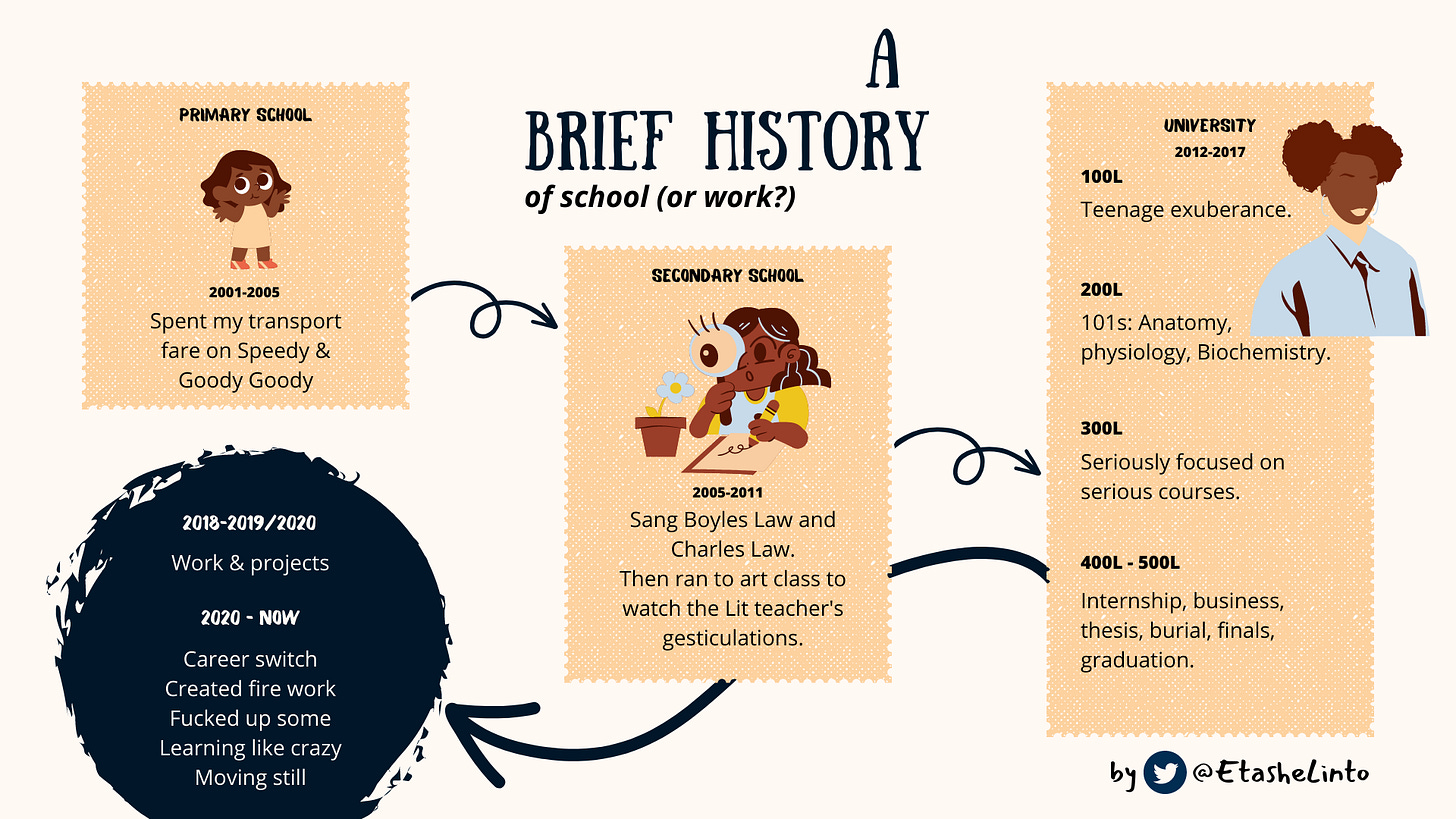
Tales of Mama Titi
Medical Therapy and Content Strategy
Growing up, my mum had a bucketful of threats for my unruly behaviors. If she wasn’t showing me the behinds of her slippers, she was pointing her cooking spoon at me with a warning on her face. But her biggest threat — that which I feared most — was a trip to a woman we called Mama Titi.
Mama Titi was a nurse in our neighborhood. She was warm and thoughtful, but also quite scary to my child self of the strong smell of drugs in her home, how she flicked the tip of a needle before injecting my bum, and the bitterness of every pill she dispensed from her cabinet. My mum, aware of my fear, would go, “I’ll take you to Mama Titi,” even when my crime was as little as refusing to eat pap for breakfast. I dreaded the thought of it all and cultivated a habit of hiding vitamin C tablets, from different treatment sessions, in a nylon bag, which I somehow imagined would save me from future trips to the nurse. Soon, I felt bold enough to rebut my mum’s threats. She’d mention Mama Titi and I’d wave my bag of vitamin C in her face, letting her see that I didn’t need to visit a health professional when I had my pack of medication. Of course, it didn’t fly. And it made no sense to me because, to my little self, treatment simply meant going to a health professional for medications. I was unaware of the unique skills and knowledge behind their decisions; the diagnostic processes, guiding policies, and treatment frameworks that went into alleviating my symptoms, all of which I now realize are also relevant to content strategy.
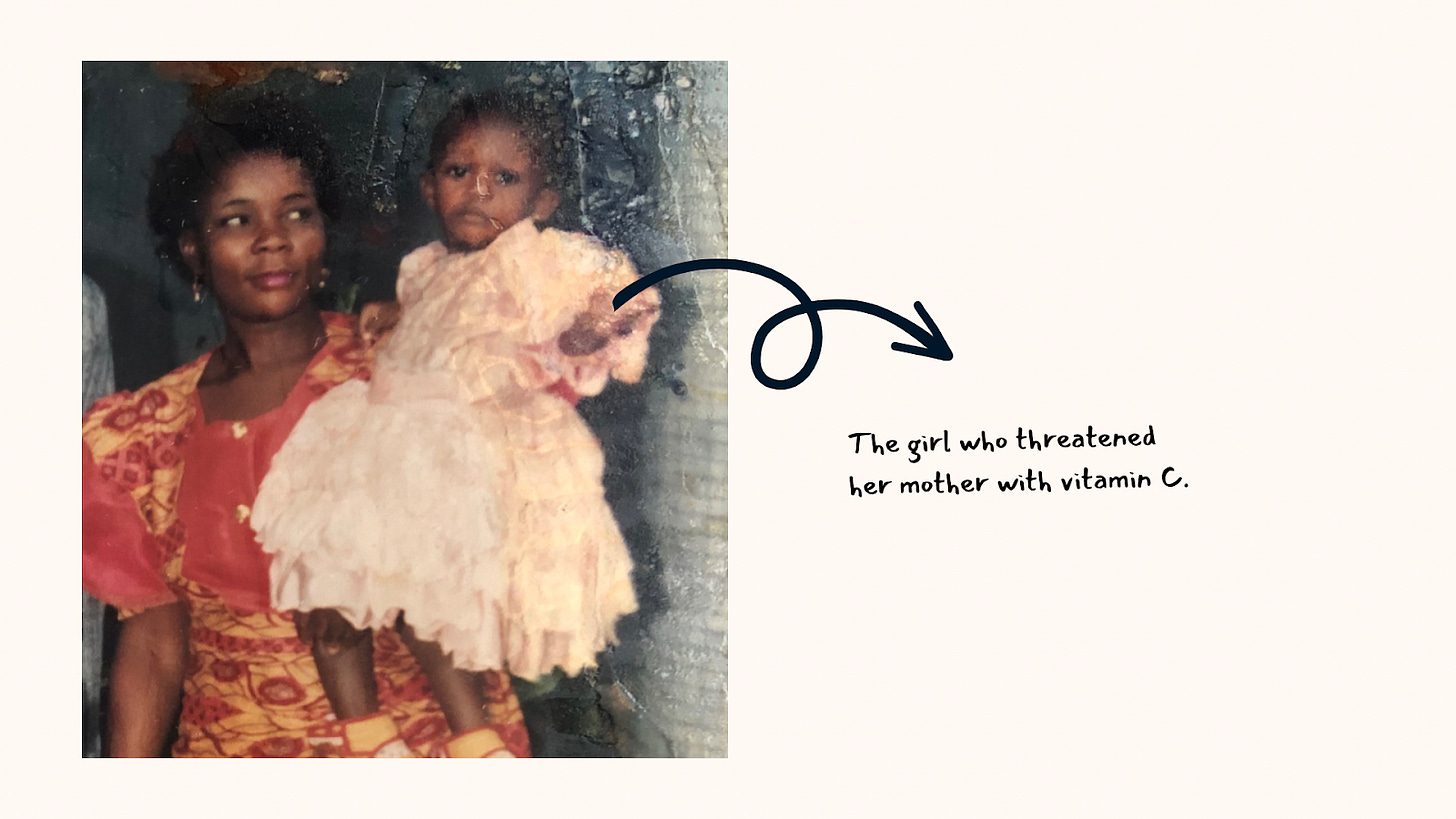
Medical therapy and content strategy are governed by similar principles. They both require you to first identify a problem before concentrating resources and taking coordinated steps toward solving the diagnosed problem. I’ll highlight the features of these principles in four parts, at least the features I’ve observed so far.
Symptoms are not the problem. When you visit a doctor with a headache, she doesn’t simply send you home with a pack of Panadol. She assesses your vitals, quizzes you to understand the type of ache you have, and collects information about your job, sleep pattern, health history, and more. Her goal is to get a clear understanding of your concerns, rule out certain health issues, and determine the right course of action for treatment. Content strategy also requires the same approach. It requires you to get past symptoms and ask important questions to unearth the core issue to be resolved. Since my start in content strategy, I’ve found that most businesses mistake symptoms for problems. They get a headache and jump right into taking Panadol without first asking the why questions. Like, “Why do I have a headache?” “Why isn’t our landing page converting?” “Why do we have low engagement on social media?” Asking why allows you to channel resources toward the right problem which, oftentimes, might not even be related to the content you produce. By failing to ask why, you end up cooling the surface-level problems without addressing the underlying issues, stunting growth in the long run.
Correlation is not causation. One of the myths I discarded after pharmacy school was the notion that pneumonia is caused by exposure to cold environments. I picked up the myth from my folks who picked it up from their folks who picked it up from god knows where. In reality, Pneumonia is caused by bacteria, fungi, or viruses. Sure, as with all respiratory issues, pneumonia can worsen during unusually cold conditions. But cold is only a correlation, not a causal factor. Similarly, a business invested in content cannot say, “Our content isn’t performing well because we don’t have sufficient funding.” Yes, you could use more funding to present your work and scale your content efforts, but it isn’t the reason behind poor performance. It’s a correlation, not a cause. As a content strategist, I’ve come to understand how items like unclear business objectives, hazy content goals, poorly defined audience types, and stale design decisions contribute to poor content performance. Solving correlations is like taking a home remedy for pneumonia without going to the doctor for proper treatment. It does nothing to treat your problem.
You need tools and knowledge to treat a problem. There are three major (sometimes overlapping) stages to treating a problem: diagnosis, therapy, and therapy assessment. Earlier, I explained how healthcare providers (HCPs) assess you to better understand your concerns. They take a holistic picture of your health before deciding the next course of action. But what I didn’t explain was how that course is set. HCPs use a host of tools and knowledge to make educated judgments for treatment. They operate with a clear understanding of broad areas like physiology and anatomy, and specific areas like your lifestyle, health history, and the meaning behind those weird numbers you see on your test results. Why do they need so much to prescribe a solution? Because you can’t treat a system without understanding its overall nature and specific conditions. As a content strategist, I knew early on that I couldn’t build a strategy without first understanding the brand’s industry and the interiors of the business. Here, the brand’s industry is the overall system while the business itself is the specific system. You can’t create a content strategy without first assessing the market, reviewing competitors’ efforts, identifying the unique strengths of the company, and pulling it all together to woo potential and existing customers.
You can’t dispense medicine without closing gaps. This one is juicy. For a long time, doctors and pharmacists around the world have sparred over the final say on a patient’s medication. Some professionals call it an ego problem on the doctor’s part, while some doctors call it a territorial encroachment by the pharmacist. Whatever you call it, it’s caused major medical errors that could’ve been avoided if the drug expert closed the gaps. Pharmacists play several roles in a clinical setting, one of which is to review a doctor’s prescription for errors. A doctor, however excellent she may be, is capable of making mistakes. And, as a drug expert, it’s the pharmacist’s job to identify the possible problems of the prescribed solution. I spent some of my clinical roles double-checking doses, identifying wild side effects, and figuring out drug interactions. Similarly, I spent the past year asking questions like “Is this topic relevant to our audience?” “Is this piece written in a language that serves them best?” “Are there any parts of this piece that they might shoot back against?” “Will this content solve a problem they face?” I also asked, “What topics do we need to address and how much content do we need to send out?” An overdose of the wrong (or the same) content would bore audiences, an underdose would affect the long-term impact of content on the business, and the wrong dose would completely shift their attention elsewhere. Without these questions, there’s no way I’d have moved The Naira Haus’ Instagram reach from 80 to over 20k in eight months, especially as a solo content person in a bootstrapped company handling multiple content verticals. Simply put, I’d have developed content that failed to drive results. Being a pharmacist requires you to be alert to potential errors in your solution, and so does content strategy.
Like medical therapy, content strategy is about identifying a problem, focusing resources and activities, and taking coordinated steps toward solving the given problem. It’s a hypothesis about what will work based on an educated judgment backed by knowledge of the business, industry, and established content principles. Shane Parrish puts it best in his article on spotting bad science. “Good science,” Parrish writes, “is science that adheres to the scientific method, a systematic method of inquiry involving making a hypothesis based on existing knowledge, gathering evidence to test if it is correct, then either disproving or building support for the hypothesis. It takes many repetitions of applying this method to build reasonable support for a hypothesis.” Content strategy is about designing a way to move an organization forward through content; focusing action and effort while making room for adjustments. I honestly don’t think I’d have nailed my first year in this industry without this knowledge running in the background.
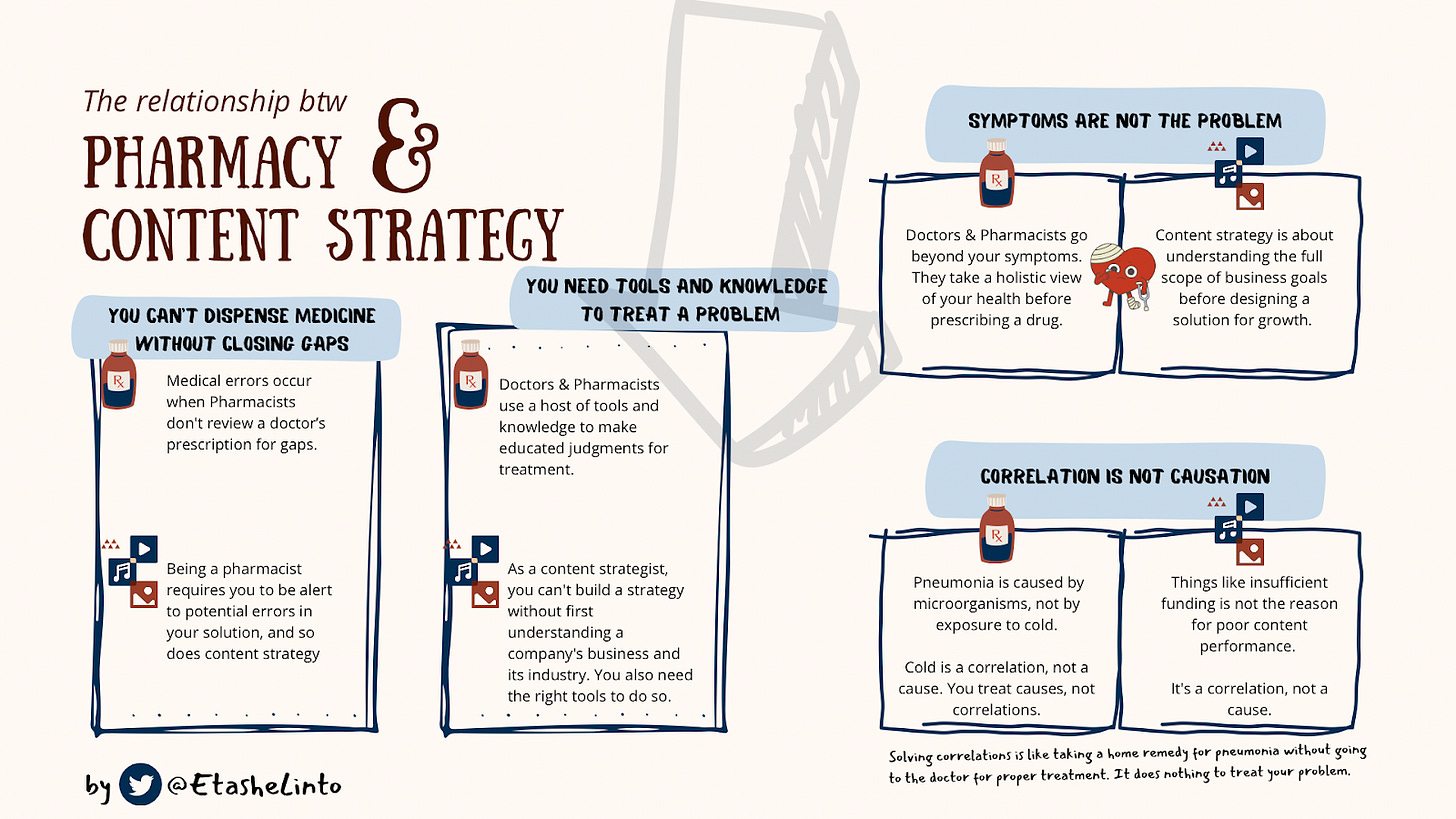
And Other Lessons
Mathematics, Content, and Other Departments
Imagine a company called The Three-eyed Raven or TTR (I know, wild name eh?). TTR is a fifty-year-old business that designs surveillance equipment for houses. They’ve recently included digital media as part of their growth efforts and have made their first digital marketing hire (a content marketer), set aside a good budget for content marketing, modernized their product designs, and contracted a sharp photographer to capture their products for digital platforms. TTR seems to be doing great, right? Now, imagine also that they have a slow, poorly designed website not optimized for mobile. Considering that 92% of people accessed the internet via mobile phones in Q1 of 2022 alone, would you still agree that TTR is doing great with its digital efforts now?
The situation with TTR reminds us of a basic maths lesson: anything multiplied by zero is zero. 5 x 5 x 5 x 0 equals zero. Good content x strong budget x improved product designs x sharp product pictures x 0 (i.e crappy website) ends up becoming zero. If you’ve read my article on giving up the search for purpose, you’ll recall how lost a girl I was in maths class. The subject always seemed like a language I could never decode but, interestingly, it helped me understand the interconnectedness of things. This knowledge is necessary for content success. All departments are connected. Create the best content all you want but it won’t do much good if it leads people to a poorly developed product. It won’t do much good if it’s presented through a badly designed banner or a website with a plain bad user experience. Content in itself is a product, and products rely on other parts of a business for success. Departments complement each other when in sync. And so a failure in one area affects growth in other areas.
Dosing and Content Compounding
Consider a plane moving from Lagos to Abu Dhabi. It has 200 passengers on board and is estimated to arrive 8 hours after takeoff. But for this plane to arrive safely, it must stop at an air gas station to refill its tank, every two hours. If it doesn’t it’ll run out of fuel and crash, killing everyone onboard. This use of fuel exemplifies how a drug operates in your body.
Okay, maybe the death part is extreme but here’s what I mean:
- Your pharmacist gives you a pack of 500mg antibiotic tablets.
- She instructs you to take one tablet every 12 hours (frequency) for 5 days (duration).
- Why?
- For a drug to work, you have to take the right dose, at the right interval (frequency), over the right period (duration).
- Just like the plane, your body is in a transition state to healing and it has an estimated time of arriving at that state.
- Plane (8 hours), drug (5 days).
- It also requires a certain amount of fuel over a given time.
- Plane (8000 gallons every 2 hours), drug (500mg every 12 hours)
- This is how long it takes your drug to move within your system before being eliminated from your body.
- So, you have to refill to maintain a steady state until arrival.
Okay, wait. How is this relevant to content creation or strategy?
Drugs work through a compounding effect. You have to take it in a timely, consistent, and patient manner to experience its long-term benefits. This is also important when thinking about growth through content strategy.
With content, I’ve learned that you don’t always see results early on. And when you’re inconsistent with quality content and impatient about its impact on your business, you position your brand for delayed growth in the future. Of course, content pieces exist to serve different purposes. If the goal is to support your sales team, sure, create the right content for that. If it’s aimed at attracting attendees for an upcoming event, focus on creating content around that. But your content strategy should go beyond these short-term goals. Think long-term. Think about how the content you create today will play out months and years from now. One of my favorite examples of companies that have approached content this way is Buffer. I’ve returned to Belle Beth Cooper’s articles from as far back as 2014 (like this one) when I needed to learn about writing, research, work, and creativity. Almost a decade later, these articles are stronger than some pieces today.
Your body crashes when you’re impatient and inconsistent with your medication. Sometimes, you won’t notice this crash because you feel alive and well at the moment. But it shows up in the future when, say, you need the same antibiotic for treatment but can’t have it because the organism has developed resistance toward it. But if you’re consistent, your symptoms fade with each dose until you arrive at your healing point. This, too, is how I think about content.
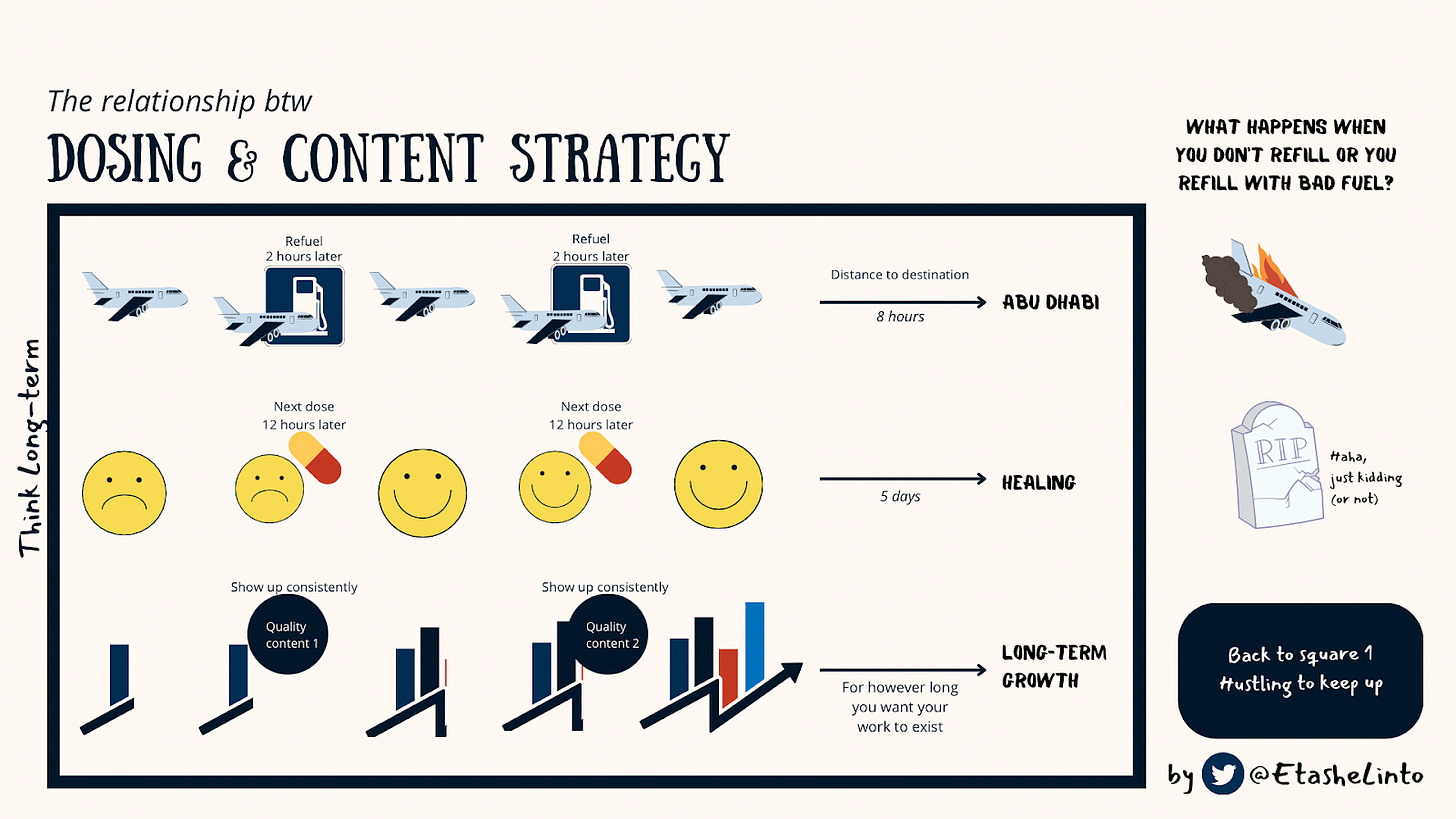
Clinical Trials and A/B Testing
The drug development process includes a clinical trial stage. Here, researchers gather two or more groups of people, administer a drug in different doses, monitor the drug’s effect on each group, and reiterate until they identify what works. This process is much more complicated than I’ve described. But it was my first introduction to A/B testing and has proved helpful for launching digital campaigns.
Of course, there are many variables to consider when performing an A/B test. But the core principle remains the same: compare two versions of something to figure out which performs better. I also find this concept useful for reviewing overall content performance. At Naush Labs, I often had to ask questions like, “What do these numbers mean?” “These two posts are quite similar so why did this post deliver and why did the other fail?” “What should we create less of or eliminate entirely?” It helped me prioritize better-performing forms of content, explore newer forms, and focus content on business goals.
People, Empathy, and Communication
Being a pharmacist means you get to interact with many different people. I spoke with doctors to clarify prescriptions, worked with nurses to explain drug administration, met with medical lab scientists to confirm test results, discussed drug products and medical devices with sales representatives, spoke with patients (the calm and distressed) about drug use, and conversed with senior pharmacists about pharmaceutical care, monitoring and evaluation processes, and much more. When you interact with this many people, particularly patients, you quickly learn the importance of language. I worked in clinical and community settings and had to navigate speaking to each person in a language they understood. I’d speak Pidgin to client A, speak English to client B, adjust my words to fit their needs, and find an interpreter or refer a client to a different pharmacist when faced with a language barrier. All of these became relevant when I had to conduct audience research and craft the creative voice of The Naira Haus. I’ve always taken an empathy-centered approach to content as I find it necessary for focusing and presenting your message to your audience. Empathy allows you to reach the heart of things, and it’s a skill I continue to use as I write personal essays and create content pieces in different formats.
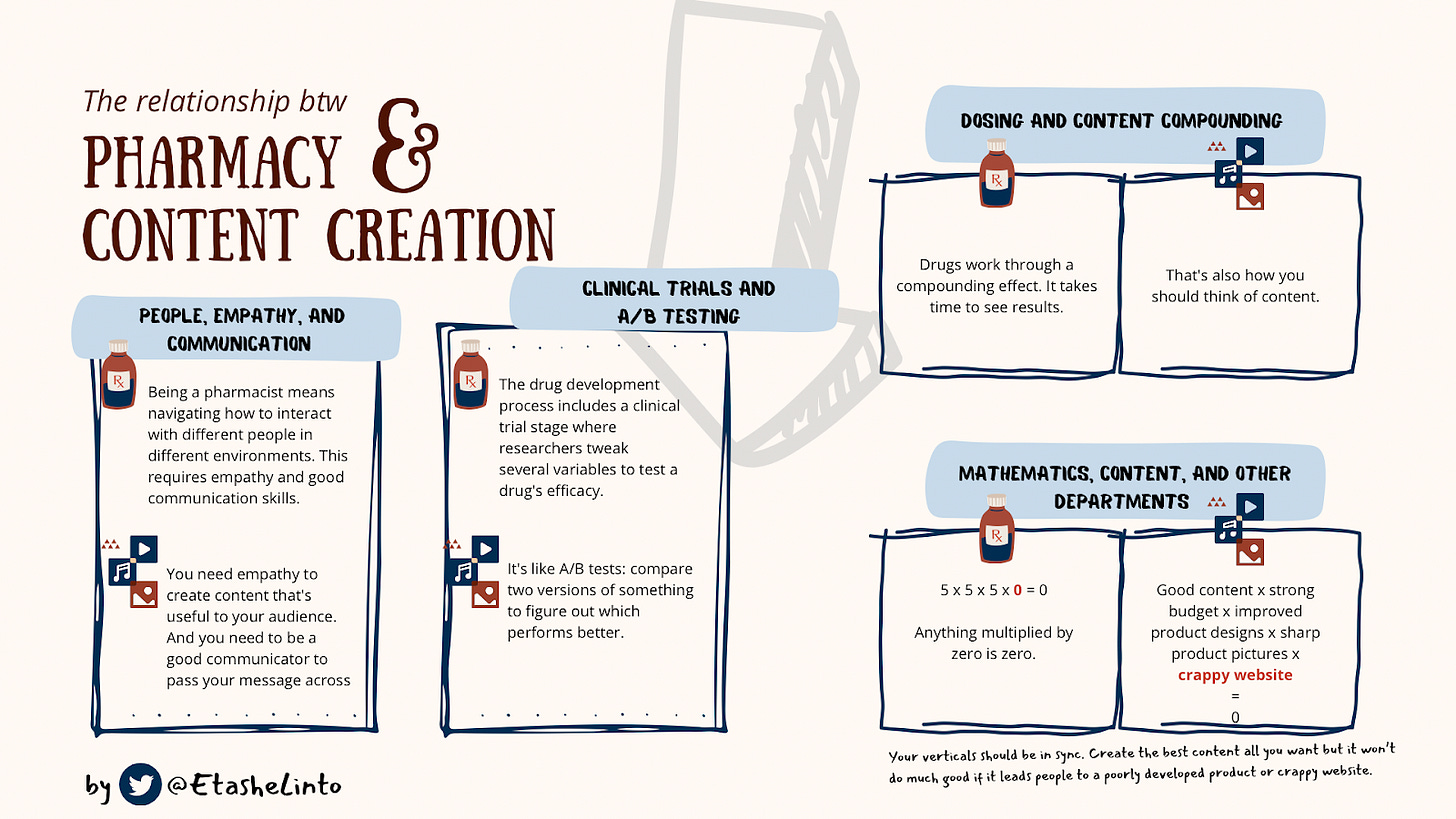
Thermodynamics and a Final Reflection
Some of the lovely humans in my personal newsletter are probably used to me restating this first law of thermodynamics:
“Energy can neither be created nor destroyed, but can be transformed from one form to another.”
I picked that up in physics class and it’s stayed with me since then. I’ve repeated it on days when my mental health decided to have a mind of its own. I’ve used it to pull my focus into creative projects. It comes in handy whenever I have to reflect on my path, reminding me that two seemingly different systems can operate with the same principles; any skill is transferable if you understand your ground and where to place each skill.
Maybe in a different dimension of the multiverse, an Etashe is killing it as a health professional. Maybe somewhere in the future, I’ll return to a pure science like physics, a dynamic field like design, or a more people-centered path like psychology, maybe not. Regardless, I’ve picked up numerous skills from the sciences — a lot of which I’m still uncovering. Science continues to direct the quality-oriented approach I take to creating. And my curiosity has balanced out that seriousness with a playfulness that translates into creativity. To be at the intersection of both is rad, and I’m pleased about that.
The past two years have been rewarding in many ways. I’ve cooked magic, baked lots of mistakes, and still have WTF! days. But it’s all led me toward a better awareness of self and, ultimately, growth. I’d love to keep working with thoughtful, creative people building future-focused products, making money from my craft, and growing like a tree.
Thanks,
To Kimmy Kemler, for writing about how your MFA in poetry prepared you for UX design. It inspired me to think about my journey and tell my story. To David I. Adeleke, for recommending the book, Good Strategy Bad Strategy, through the CLC Program. It helped me see, for the first time, the unique skills and qualities I’d built in the sciences, and how they’ve influenced my approach to content development. To Shane Parrish and his team at Farnam Street, for making public the mental tools that helped me connect the dots between science and art.
To you, for reading. I’d love to hear from you if, like me, you’ve made (or are making) a career transition. What parallels have you drawn between your previous and current field? What lessons excite you the most from your journey?
 @etashelinto
@etashelinto